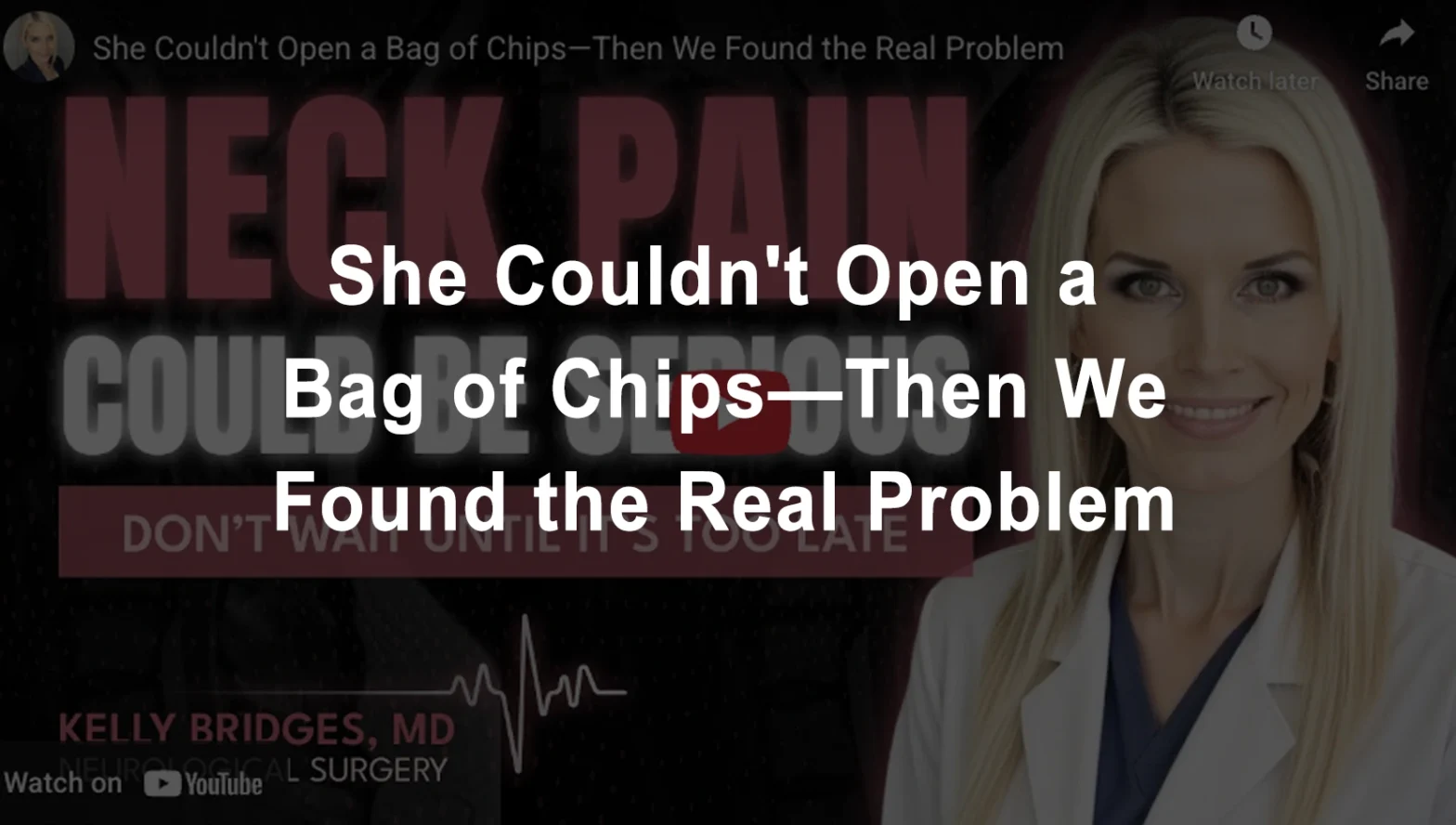She Couldn’t Open a Bag of Chips—Then We Found the Real Problem

When Neck Pain Becomes More Than an Annoyance
Have you ever struggled to open a simple bag of chips? For most of us, it’s something we hardly think about. But for one of my patients, it was a daily reminder of how her body was letting her down.
As a board-certified neurosurgeon, I want to share with you a remarkable story of transformation through an anterior cervical discectomy and fusion, or ACDF, surgery. You see, neck pain isn’t just about discomfort. It affects approximately 30% of people at some point in their lives. But when that pain starts interfering with simple daily tasks, it could be signaling something far more serious.
In this video, I’ll walk you through a case that perfectly illustrates when neck pain becomes a warning sign you can’t ignore—and how surgical intervention can be life-changing when chosen at the right time.
Understanding When Surgery Becomes Necessary
Before we dive in, let me share something important. As a neurosurgeon with years of experience in spine surgery, I’ve seen countless patients struggle with the decision of whether or not to pursue surgery. It’s never an easy choice.
But what makes this particular case so compelling is how it demonstrates the clear signs that indicate when conservative treatment is no longer enough—and how the right surgical intervention can restore not just function but independence and joy to someone’s life.
The Patient Who Couldn’t Open a Bag of Chips
Let me introduce you to a patient whose story deeply moved me. This lovely woman came to our clinic with what might seem like a minor issue: she could no longer open a bag of chips with her hands. Rather, she had to use scissors.
But this was just the tip of the iceberg. Her grip had become so weak that she had to give up her beloved craft projects. She also could no longer raise her arms up to her head to wash her hair. She experienced intense pain radiating from her neck into both of her shoulders, accompanied by numbness and tingling in her arms and hands. Her right arm was progressively getting weaker, making everyday life increasingly more challenging.
The Diagnosis: Severe Compression and Spinal Cord Injury
We began by evaluating her symptoms and reviewing diagnostic studies of her cervical spine, which is in the neck. In doing so, we uncovered several concerning findings.
The natural curvature of her neck had diminished, and there was significant wear and tear on the discs between her vertebrae. But what really caught our attention were two critical areas where the discs were protruding into the canal around her spinal cord, severely narrowing that area.
This wasn’t just about pain anymore. The MRI showed clear signs of spinal cord injury. And at three different levels, the pathways for the nerves traveling to her hands were severely constricted.
This combination of factors explained her symptoms, but it also raised a red flag about her future. Without intervention, she was at risk of permanent damage. The structural problems in her neck could not be fixed with non-surgical treatments.
Even more concerning was that if she had experienced even a minor injury to her head or neck, her spinal cord was at risk of serious damage. The possibility of her weakness becoming permanent was very real.
The ACDF Surgery and What Happened Next
After carefully discussing her options and the risks involved, she made the decision to move forward with an ACDF surgery. During that procedure, we worked under a microscope and meticulously removed the damaged disc from around her spinal cord using an instrument measuring just 1 mm in width.
We relieved the pressure on her spinal cord and nerves. To stabilize her spine, we placed small implants, including a plate and screws, ensuring everything would stay in place as her body healed.
Within two weeks of surgery, she returned to our clinic with news that brought joy to our entire team. Her pain had significantly improved, and for the first time in years, she could enjoy her craft projects—something she thought she’d never do again.
Within six weeks of surgery, her pain, weakness, and numbness were completely gone. A follow-up MRI showed her spinal cord was no longer compressed and that prior injury was actually healing.
Lessons from Her Recovery
This case illustrates a crucial point about spine health: sometimes what seems like a simple inconvenience—struggling with everyday tasks—can actually be your body warning you about a serious underlying condition.
While not every case of neck pain requires surgery, it’s vital to recognize when your symptoms might be signaling something more serious. If you’re experiencing persistent neck pain, weakness in your arms or hands, or difficulty with simple tasks, don’t wait until it becomes an emergency.
These symptoms could be warning signs of a condition that needs medical attention and possibly surgical intervention. The earlier you seek help, the more options you’ll have for treatment.
Takeaway: Listening to Your Body
Remember, your body has an incredible capacity to heal when given the right care at the right time. Whether it’s through conservative treatment or surgical intervention, the goal is always the same—to help you return to the activities you love and live your life to the fullest.
If you found this video helpful, please like, subscribe, and share with others who might find it helpful as well. And I’ll see you next time.
